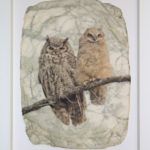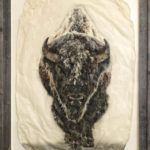Pete Zaluzec forges new paths in the world of wildlife art
By Elizabeth L. Delaney

Pete Zaluzec, Last Look Back, mixed media, 17 x 26.
This story was featured in the March/April 2020 issue of Southwest Art magazine. Get the Southwest Art March/April 2020 print issue or digital download now–then subscribe to Southwest Art and never miss another story.
CHICAGO ARTIST Pete Zaluzec introduces elements of his urban upbringing into a body of work centered on beautiful wildlife in bucolic surroundings. His photographic prints couch traditional animal imagery within a contemporary aesthetic, monumentalizing each figure in an austere, universal ground, untethered from tradition.
Combining his appreciation for contemporary art and his love of the untamed western landscape, Zaluzec manages to dovetail his two disparate passions into art pieces that are at once representational portraits and cutting-edge compositions. Further, they are the emblems of a career filled with visual and material exploration and innovation.
“I’ve always plugged into artwork, from the earliest age I can remember,” says Zaluzec, who realized his love for drawing as a young child. His mother had an interest in the arts, especially photography, and as he saw her create, he decided to give it a go as well. “I picked it up there, at that early age,” he remembers. “It’s with you forever.”
He also developed an interest in animals early on, visiting zoos and museums with his parents. “It stuck with me and grew,” he says. As an adult, Zaluzec loves being outdoors, camping, hiking, and photographing wild animals. He cites these experiences as the “driving force” behind his artwork and notes that he’d be doing the same thing even if it didn’t serve his artistic vision. “I love being out there,” he says simply.
Zaluzec attended the School of the Art Institute of Chicago, where he formally honed his skills and took notice of the contemporary art around him. His fascination with new and cutting-edge work stayed with him and ultimately figured into his own style going forward, as he sought to fuse his love of wildlife with his sense of modern design.
“Artwork has always been part of everything I’ve done,” says Zaluzec when discussing his professional life, which has included several careers in addition to his art practice. Before he made the leap to full-time artist seven years ago, he taught art and wood shop in high school, then spent nearly three decades working in architectural and custom woodworking. Although he now makes art exclusively, Zaluzec nevertheless continues to employ the means and methods from his earlier endeavors.
- Pete Zaluzec, Cottontail, mixed media, 40 x 30.
- Pete Zaluzec, Elk Bugle, mixed media, 17 x 26.
- Pete Zaluzec, Owl Pair, mixed media, 26 x 20.
Today his striking photo prints emblemize the fusion of his creative and intellectual processes, and he seems to enjoy the engineering of the practice as much as the creating itself. “I’m really process-oriented and structured in everything I do,” he explains. Indeed, his artwork is the result of a meticulous, refined process that the artist has invested years in mastering.
Though Zaluzec’s art is based in photography, it is a distinct departure from any singular medium. The finished pieces incorporate digital editing, printing, painting, and sculpting techniques to realize the final result.
Perhaps the most notable aspect of Zaluzec’s work is the durable yet delicate paper he uses to display his images. Named for the bush from which bark is harvested to make it, Gampi paper is a traditional Japanese washi, or handmade paper. Its strong, nearly invisible fibers provide a smooth, satin surface on which to print. Meanwhile, the translucent nature of the paper allows for high contrast and detail. “It gives a character you can’t get from just passing one sheet of paper through a printer,” says the artist.
ZALUZEC’S CREATIVE process begins in the field where he takes his photos. As he puts it, “This part has become an important part of my life and process, and I look forward to this as well as my artwork.” He photographs wildlife with a camera that can take up to 16 shots per second, affording him a vast array of gestures, characteristics, and details from which to choose.
Zaluzec remarks, “Being out in the field, out in the backcountry photographing animals—that’s a really comfortable place for me to be.” Over the years, he has shot thousands of animal images across the western United States and in Canada, in places such as Yellowstone National Park, Utah, Montana, Manitoba, the Grand Tetons, and the Canadian Rockies. He loves being out in the elements and goes on weeks-long photography expeditions three or four times a year. “Spending extended time in the field allows me to capture a large range of animal behavior and activity,” the artist says. “I can spend hours or all day long with the same animal, as long as it cooperates.”
- Pete Zaluzec, Running Grizzly, mixed media, 17 x 26.
- Pete Zaluzec, Snow Bison, mixed media, 60 x 40.
- Pete Zaluzec, Corkscrew, mixed media, 40 x 30.
Wolves, coyotes, birds, and bears are among his most frequently depicted subjects; he knows how to spot the signs of their presence—a carcass, for instance, might announce the presence of wolves nearby. And though Zaluzec loves every animal he has the privilege to encounter, he admits that the wild horses of Utah’s West Desert are “one of the most fun to photograph.” More social and less intimidating than some of his other subjects, like polar bears, the horses sometimes allow the artist to insinuate himself into their herd as they trot around the wide-open space. Zaluzec’s earlier work consisted largely of sculpture, and he began photographing the animals strictly as reference material for his three-dimensional work. One day it occurred to him that the photos could stand on their own. However, he wanted to push the envelope on conventional nature photography, to incorporate his contemporary design roots and present the photographs in a new way.
“Photography is not the end of what I’m doing—it’s pretty much the beginning,” says Zaluzec. One might say that the photographs serve as his medium—fluid, malleable, yielding to the artist’s creative direction. As such, the images undergo an extensive editing process before they’re ready to be printed. He isolates the figures, removing them from a traditional, nature-based setting and casting them in a new, unexpected perspective. He adjusts light, contrast, and other elements to create heady shades that work in tandem with the Gampi paper’s parchmentlike coloration. (Though he shoots in color, the Gampi tends to diminish the original photographic hues.) The amplified tones, lines, and textures create visual weight, depth, and an almost hyperreal quality to the animals. Complex and meticulous, this step alone takes the artist anywhere from a few hours to a few days to complete, depending on the composition.
ZALUZEC does all of his work in a well-equipped studio outside his house, where he engineers and executes every part of his process, from the initial photo editing to the custom framing for each piece. A large-format printer allows him to print images up to 6 feet tall—a careful enterprise on the paper he uses.
Once Zaluzec finishes editing the photograph, he prints it twice so that he has two identical images on the Gampi paper. He then lines up the printed images and fuses the sheets of paper together with a liquid ground. At this point in the process, he manipulates the wet paper to create folds, lines, and other textures that add an organic, dynamic aspect to the piece. Once dry, these irregularities become a permanent part of the paper’s makeup, existing as both visual and physical elements within the work.
- Pete Zaluzec, In the Wind, mixed media.
- Pete Zaluzec, Longhorn, mixed media, 17 x 26.
- Pete Zaluzec, Unconcerned, mixed media, 26 x 20.
The resulting images are highly saturated, sophisticated representations of a creature elevated from its typical natural surroundings but still retaining its instinctive wildness. Not quite three-dimensional, Zaluzec’s prints nevertheless create a sense of depth and subtle movement that reverberates across and throughout the surface. At once protruding and receding, they float in the liminal area between picture plane and viewer space.
Zaluzec’s prints began as an effort to pair his love of wildlife with his interest in contemporary art. “One of my objectives was to do wildlife artwork with a contemporary presentation,” he says. “I did not want to distort or exaggerate the anatomy or color of the animals, just the presentation.”
The pioneering pieces did not emerge fully formed but rather are the outcome of his persistent experimentation with various papers and techniques that could combine to produce the visual effects he wanted. Zaluzec has been working with the Gampi paper for about 15 years now and over that time has continued to evolve his process and style. Squared corners and straight edges have morphed into softer, more natural line transitions, and he has amplified his manipulation of the paper as a whole, adding more apparent folds and pockets to the picture plane.
Throughout his career and the refinement of his process, Zaluzec has consistently focused on the visual aspects of his work—composition, values, line quality, and other principles of design—to engage viewers and set his work apart. He has sought to augment the beauty of a straight photo through his contemporary lens, while also translating his love of nature and animals into two-dimensional space. “I wanted to find a nontraditional way,” Zaluzec says. And with his Gampi prints, he has done just that.
representation
Park City Fine Art, Park City, UT; Mountain River Group, www.mtrivergroup.com; Astoria Fine Art, Jackson, WY; Raitman Art Galleries, Breckenridge and Vail, CO; Broadmoor Galleries, Colorado Springs, CO; Creighton Block Gallery, Big Sky, MT; Kneeland Gallery, Ketchum, ID; Davis & Blevins Gallery, Saint Jo, TX; Mountain Trails Fine Art, Santa Fe, NM.
This story was featured in the March/April 2020 issue of Southwest Art magazine. Get the Southwest Art March/April 2020 print issue or digital download now–then subscribe to Southwest Art and never miss another story.
MORE RESOURCES FOR ART COLLECTORS & ENTHUSIASTS
• Subscribe to Southwest Art magazine
• Learn how to paint & how to draw with downloads, books, videos & more from North Light Shop
• Sign up for your Southwest Art email newsletter & download a FREE ebook














